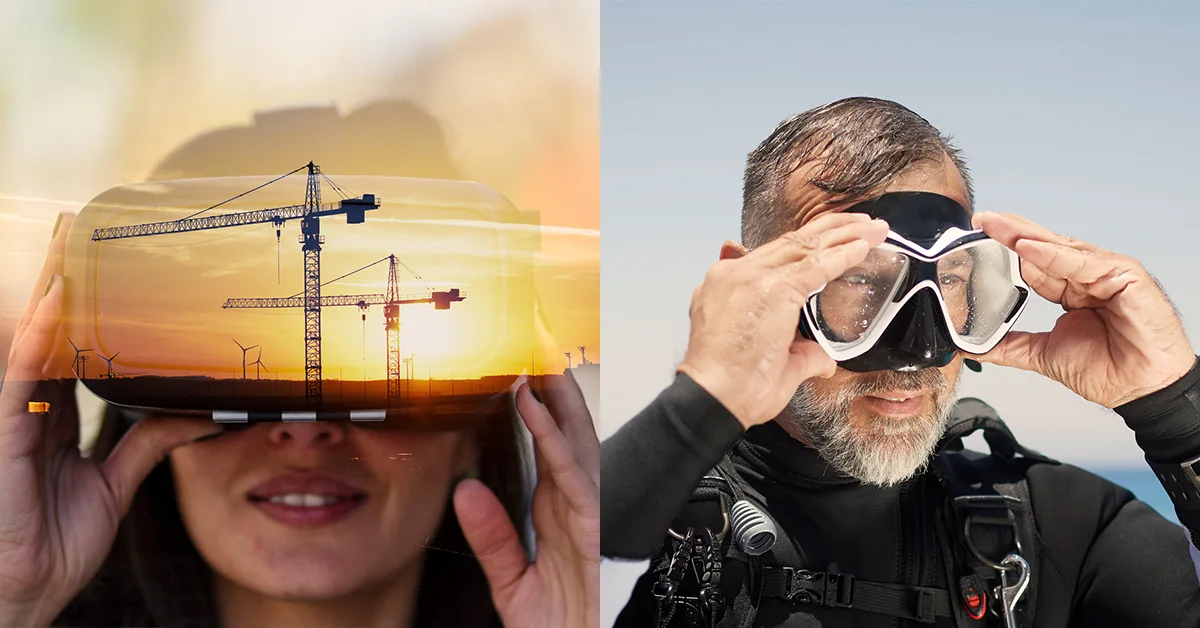
Crédits photos : Vixel
Virtual Reality (VR) meetings are very effective when they are organized and executed in a professional manner. Like any meeting, they require preparation, an agenda, targets, and timing. But unlike other meetings, they will transport the participants into a Virtual Reality space. This means the standard rules will have to be adapted. Philippe Acas, Chief Business Officer of Vixel, shares his experience.
We will be focusing on meetings with multiple users, each at different geographical locations. More precisely in construction projects, specifically using an openBIM environment where IFC and BCF are being used.
Let us say that the part of your project you would like to have a meeting about is ready to be shared with others. – That is to say, “Shared level” according to ISO 19650, or MMI 300. – Your models are most likely gathered in an openBIM platform or Common Data Environment. This allows you to easily bring your models to VR using Vrex or other VR-applications, and share access with others such as architects, engineers, user representatives, and other stakeholders involved in the projects.
Your VR meeting can take many forms. It can have two people, or a dozen, or more. It can be informal, it can be highly structured like an ICE session, or somewhere in between. We will be describing somewhere in between these below.
Performing a VR meeting is similar to preparing for a dive in the sea. You have your equipment, buddies, a dive plan, timing, exit point, and debriefing with notes. So, let us dive into it!
1. Prepare an agenda
You need to make a clear agenda. In an openBIM context it makes sense to prepare the agenda as a list of BCF issues to be discussed in the VR session. These BCFs will have the locations of each meeting topic. You access them in VR directly from your BIM platform or shared data-environment. Vrex synchronizes BCFs both ways, so they are easy to access in VR, and to add comments and create new ones directly back from inside VR, thus making it a very effective agenda tool.
Plan proper timing for each BCF to be discussed. Overloading the BCF list might lead you to rush topics, or making the VR meeting take too long (As with a dive, no more than 45 minutes straight is recommended). Your IFC models are of course the latest version.
2. Send a complete invitation
The invitation should include the following:
- A clear agenda, with a time and date
- An access code for the VR room, as well as a link to the pre-video conference
- Describe what kind of preparation is expected from the attendees.
- Invite participants to join a How-to briefing session
3. Offer a how-to briefing for new VR members
Someone new to VR may be intimidated or insecure about using the technology. To avoid unnecessary stress and lost time during the meeting we recommend having a pre-meeting session with these members.
Give them a reasonably good understanding of how the menu and tools work, how to view BCF issues, etc. This also gives you the chance to check that their IT department has granted them access to use VR for outside communication.

4. Set a video conference 15 min prior to the VR meeting
We recommend planning 15 min before the VR session, to make sure everyone’s connection is working properly as this is the main problem that could arise. Similarly to traditional video-call meetings, there is always someone without proper equipment settings, bad batteries, or having some other impediment. .
This will of course be a good time to introduce the attendees to each other if they are not already familiar.
You may have attendees that do not have VR equipment. They can participate using their standard windows laptop, or as a group using their big screen in their meeting-room.
They will have some reduced capacity compared to those in VR, but can participate in the discussions, create BCF issues, so in most ways they will share the VR experience.
It is a good practice to let the laptop users make detailed notes, so the VR members do not have to spend time doing this. Coordination can be challenging when needing hundreds of workers to be in the same area at the same time. VR technology leaves the team with much more flexibility. Tune in from home, and you can work within the model with the rest of the crew.
Keeping the video-conference session open during the VR meeting could be useful, if any of the participants has sound issue or need to communicate outside of VR. And, of course, it is good to debrief on a video-call after the VR session to finalize decisions.
NB! Make sure to mute the video-call to avoid hearing an echo through two audio sources.
- Review the meeting agenda and targets
- Review the VR etiquette
- Welcome and introduce attendees
- Check VR connections
5. Keep the VR meeting within 45 min
Being immerged in a VR environment requires concentration and focus and could be tiring for some people, especially new VR users. If you need to extend the VR session to longer than 45min, we recommend you take a short 5min break to allow attendees to regroup their senses before another “dive”.

6. Respect the VR etiquette
Yes, just like in a dive, VR has an etiquette that needs to be respected. Following these simple rules of behavior will make the meeting more effective and pleasant for everyone. Seeing as you will be several people inside the model, where it is so easy to fly around, a certain amount of discipline must be enforced. You also have features that impacts other members view inside the meeting and you need to use them carefully:
- Do not fly all over the place, but wait for other members to join.
- Greet them and do a simple sound check for everyone to make sure their mic works.
- Wait for the meeting host to begin the meeting by bringing the group to the first agenda point for discussion.
- Stay with the group as much as possible when discussing issues
- Avoid lagging behind the group from playing around
- Mute yourself if there is noise, keep in mind that everyone hears you
- In VR some functionalities will affect all participants. If you hide or slice an object this changes the view for everyone, so use it carefully. Make sure you restore the view to its original state when you are done.
- Do not teleport others without letting them know, you may interfere with something important they are studying and it could be difficult to get back to. Also, it is not polite.
- In short; Do controlled operations and communicate clearly.
7. The host shall lead the meeting
There should be a designated meeting leader who takes control of the agenda, who is in charge of bringing the group to the different locations. This is particularly important if some participant is either new to VR, or not too familiar with the project. You do not want to swim in the blue alone…
- The host should aim to be the first to join the VR meeting
- Welcome the other members
- Check that all the member’s sound is working correctly
- Open the first agenda point (BCF), and share it with the group
- Make sure the group is ready before you move them all to the location of the first topic
- Use your laser-pointer to show everyone what is being discussed. Remember that some users may be standing backwards in their living- room.
- Follow these steps for each agenda-point (BCF)
- Create new issues if necessary or add comments to existing ones.
- Conclude the meeting, and invite everyone to join the debrief
8. Allow free exploration towards the end of the session
VR is all about exploring and get a new understanding of the project. It is recommended that, after the agenda is completed, to give some free time to participants to explore on their own. If they find something noteworthy, they can ask other members to join and check it together or create a new BCF issue for future examination.

9. Debriefing the VR experience with a BCF check and a questionnaire
When the agenda and free exploration is done, the meeting host asks all members to exit VR and go back to the video-conference meeting to debrief the VR session:
- If some members are new to VR, ask them about their first impressions.
- Get feedback about the session, what can be improved for the next. In this case you could use a simple questionnaire to track a trend in key points regarding the VR experience.
- Summarize the issues treated and created during the session and tasks to be followed up
10. Analyze the VR efficiency in the meeting
By choosing to use a VR solution you must have set some targets in terms scope of use, cost and time savings, discovery of new issues, user satisfaction …
To be able to gather data for a full global analysis of the VR effectiveness in your workflow, we recommend that you create a standard spreadsheet for each meeting with these minimum points:
- Did we solve the issues from the agenda?
- Did we detect new issues?
- Did we run into problems we could not solve remotely inside VR?
- How much travel time was saved by using VR for this session?
- How much travel cost was saved?
- Did we get any insight or find any issues we would not have found using other methods?


